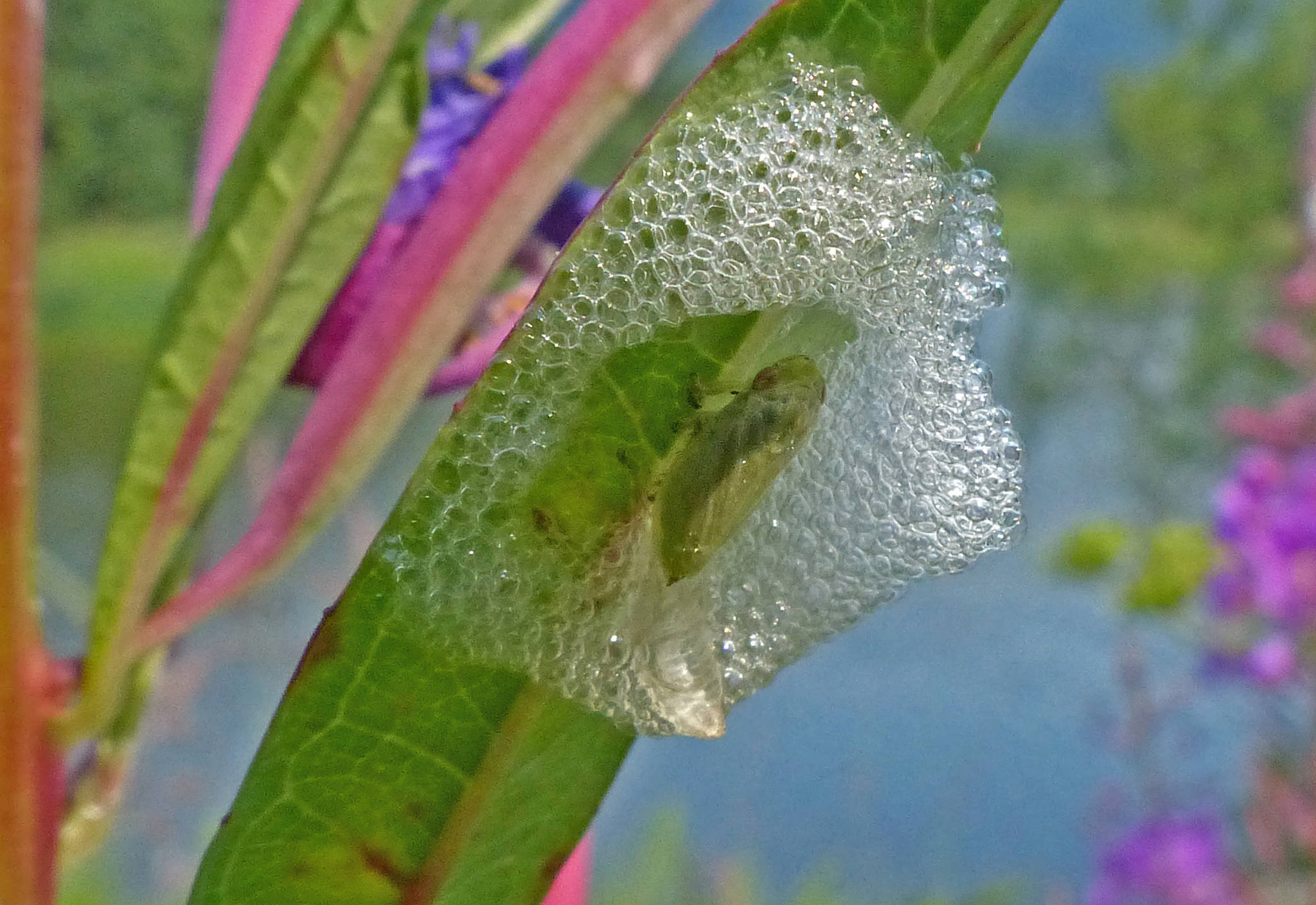If you can remember back to our so-called summer, you may remember seeing little clots of whitish bubbles on some of the vegetation. Those bubble masses are made by young spittlebugs, known as nymphs. Another common name for them is froghoppers. The adults are small and superlative jumpers (hence the frog analogy), easily eluding your notice; they may also be confused with other kinds of bugs, such as leafhoppers. But the bubble masses are quite evident, if you look.
An ever-helpful entomologist at UAF suggests that our local species is probably the meadow spittlebug (Philaenus spumarius), which occurs in Europe and North America. The adults are highly variable in color and pattern, making it a popular subject for genetic studies. This species feeds on a wide variety of plants; both nymphs and adults suck out plant juices by poking their beaks into plant stems and leaves. Plants with tough stems and leaves or with a hairy surface are difficult to exploit, especially for nymphs.
Females may mate with several males, so one batch of eggs may have more than one father. Females lay their eggs in crevices in buds and grass stems or by inserting them into plant tissue via a slit that the female makes. The eggs overwinter and hatch in spring and summer. When an egg hatches, the long-legged nymph breaks out by pushing a hard egg-bursting plate against the egg shell. The nymph then runs around in search of a place to feed. Inserting its beak, it sucks up plant sap. Much of the water, along with the sugar, that it draws up is not digested but bypasses most of the digestive tract, going directly to the rear end. This ‘excess’ fluid flows out and sticks to the nymph and its plant, becoming a drop that covers the tiny new-hatched nymph. The young insect can still breathe, by poking its abdomen out of the drop and letting air in to the breathing apparatus, which opens under the abdomen.
Each nymph goes through five stages (called instars), separated by a molt of its outer cuticle. This takes up to about three months. As the tiny insect grows, it starts to create bubbles by pumping air out of the abdomen into the drop on its rear end. Its long front legs are used to kick the bubbles forward over its body. The bubbles are sticky, so they don’t collapse quickly. A nymph can make enough bubbles in less than half an hour to cover itself completely. Spittlebugs are the only insects known to do this.
The bubble mass apparently protects the nymph from some parasites and predators, but nevertheless, many kinds of insects, spiders, and birds can attack the young spittlebug. The bubbles may also provide some protection from temperature changes and desiccation.
If a nymph is disturbed or its plant withers, it wanders around, looking for a new place to feed. Then it inserts its beak and starts to exude more fluid and more bubbles. Sometimes a wandering nymph finds another bubble mass and then may join its inhabitant; in some cases, dozens of nymphs may share a communal bubble mass. However, the outcome of joining a communal feeding group can lead to a trade-off: experimental studies show that as that number of nymphs in a group increases, the survival rate decreases; the survivors, however, may be bigger than singletons. The trade-off arises because it seems that several nymphs together are better able to penetrate tough tissues and tap into the plant’s sap flow, but the competition among them is more severe, reducing survival. The good competitors win out.
When the nymph is ready to become an adult, it spreads out its now-developed wings to dry. Different species do this in different ways: some just sit in their own bubble mass and some crawl out and cling, quite exposed, to a leaf blade. Others (apparently including ours) produce a new kind of bubble, more gelatinous, with which they create a sheltering dome over the body. When the wings are dry, the adult is off and away. When adults feed, they eject drops of excess fluid (called honeydew) forcibly over the head.
Although they are sometimes abundant in certain locales, spittlebugs are nowhere near as diverse and common here as they are farther south. And only one is known from the Arctic.
• Mary F. Willson is a retired professor of ecology.

